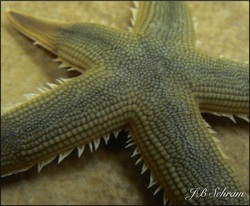Sea Star Regeneration
|
I have investigated some of the effects of decreasing pH on arm regeneration of the common soft bottom sea star Luidia clathrata, commonly found around the Gulf of Mexico, in addition to making some general observations on their regenerative ability.
I continue to be interested in investigating the organismal and ecological responses of marine organisms performing routine survival functions, such as regenerating or healing, while exposed to altered abiotic conditions. This type of investigation can help us understand more about the underlying mechanisms. |
Arm regeneration
One field study found that the incidence of regeneration in the common soft bottom sea star Luidia clathrata in Tampa Bay, Florida found that approximately 12 percent of the population were in the process of regenerating arms after suffering very significant (defined as regenerating four or five arms) bodily damage.
Because regeneration is so prevalent in this population, I decided to determine the impacts of seawater acidification on the ability of sea stars to maintain and regenerate their somatic and reproductive body components as well as sustain the calcification of their magnesium-rich calcite skeletal elements (ossicles). As sea stars commonly exhibit regeneration, this provides an excellent model to evaluate whole organ as well as biochemical and energetic consequences of acidification during regenerative processes.
As such, I examined the impacts of near-future ocean acidification on rates of arm regeneration, regenerated arm length, total body growth during arm regeneration, nutrient storage indices of intact and regenerated arms, allocation of organic and inorganic constituents in body wall and pyloric caecal tissues of intact and regenerated arms, behaviors stimulated by feeding, and organismal righting responses (a measure of stress) over a 14 week (97 day) period in the sea star Luidia clathrata. We found that predicted near-term levels of ocean acidification (seawater pH 7.8) did not significantly impact whole animal growth, arm regeneration rates, biochemical composition, or righting behavior in the soft bottom sea star Luidia clathrata common in the Gulf of Mexico and Florida, USA.
Because regeneration is so prevalent in this population, I decided to determine the impacts of seawater acidification on the ability of sea stars to maintain and regenerate their somatic and reproductive body components as well as sustain the calcification of their magnesium-rich calcite skeletal elements (ossicles). As sea stars commonly exhibit regeneration, this provides an excellent model to evaluate whole organ as well as biochemical and energetic consequences of acidification during regenerative processes.
As such, I examined the impacts of near-future ocean acidification on rates of arm regeneration, regenerated arm length, total body growth during arm regeneration, nutrient storage indices of intact and regenerated arms, allocation of organic and inorganic constituents in body wall and pyloric caecal tissues of intact and regenerated arms, behaviors stimulated by feeding, and organismal righting responses (a measure of stress) over a 14 week (97 day) period in the sea star Luidia clathrata. We found that predicted near-term levels of ocean acidification (seawater pH 7.8) did not significantly impact whole animal growth, arm regeneration rates, biochemical composition, or righting behavior in the soft bottom sea star Luidia clathrata common in the Gulf of Mexico and Florida, USA.
|
Body wall regeneration
In a short note published in the Gulf of Mexico Science, I documented the rapid regeneration of the aboral central disc, the region near arm intersection on the 'top' of a Luidia clathrata individual in under 30 days. For the full text of this article, please see the Gulf of Mexico Science website or here. Photographs depicting the loss and regeneration of the body wall over the central aboral disc in an adult individual of the sea star Luidia clathrata (R = 6.0 cm). A. 12-hr post loss of body wall over central region of disc. B. Day 10: Elongation and narrowing of body wall surrounding region of disc autotomization. C. Day 18: Body wall of aboral disc resealed; irregular pattern of body wall ossicles at zone of regeneration. D. Day 29: Regeneration of body over aboral disc complete. |



